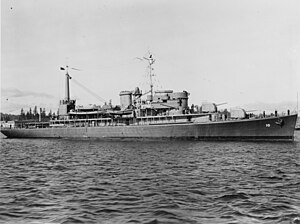Barnegat-class seaplane tender

USS Barnegat (AVP-10), lead ship of the Barnegat-class small seaplane tenders, in Puget Sound on 14 October 1941
|
|
| Class overview | |
|---|---|
| Name: | Barnegat |
| Builders: |
|
| Operators: | |
| Preceded by: | Lapwing class |
| Succeeded by: | None |
| Built: | October 1939-July 1946 |
| In commission: | July 1941-January 1973 |
| Planned: | 41 |
| Completed: |
|
| Cancelled: | 6 |
| Lost: | 0 |
| Retired: | 35 |
| Preserved: | 0 |
| General characteristics | |
| Class and type: | Barnegat-class small seaplane tender |
| Displacement: |
|
| Length: |
|
| Beam: | 41 ft 1 in (12.52 m) |
| Draft: | 12 ft 5 in (3.78 m) full |
| Installed power: | 6,000 to 6,080 horsepower (4.48 to 4.54 MW) |
| Propulsion: | Diesel engine, two shafts |
| Speed: | 20 knots (37 km/h) 23 mph |
| Range: | 6,000 nmi (11,000 km; 6,900 mi) at 12 knots (22 km/h) 13.5 mph |
| Capacity: | 80,000 US gallons (300,000 L) aviation fuel |
| Complement: |
|
| Sensors and processing systems: |
Radar, sonar |
| Armament: |
|
| Aviation facilities: | Supplies, fuel, berthing, and repairs for one squadron of seaplanes |
The Barnegat class was a large class of United States Navy small seaplane tenders (AVP) built during World War II. Thirty were completed as seaplane tenders, four as motor torpedo boat tenders, and one as a catapult training ship.
Before World War II, the United States Navy foresaw a need for a large force of seaplane tenders in the event of a war in the Pacific, to allow air operations from undeveloped islands and atolls. Full-size seaplane tenders (AVs) were designed to support two squadrons of flying boats each, but they were more expensive to build and had a deep draft, precluding their use in shallow harbors. The U.S. Navy therefore also planned for "small seaplane tenders" (AVPs), with a shallower draft, capable of supporting only one squadron each, but cheaper to build and able to operate in shallow waters. The AVPs were not the descendants of the "seaplane tenders (destroyer)" (AVDs), which were converted from old destroyers because the Barnegat class could not be built quickly enough to meet the needs of the Navy at the start of the war. Both the full-size and small seaplane tenders were designed to provide supplies, spare parts, fuel, repairs, and berthing for assigned seaplane squadrons, and were well-armed so that they could serve as the primary line of defense of the seaplane bases they set up.
The Barnegat-class ships were the first purpose-built AVPs, prior ships carrying that designation having been minesweepers. In addition to carrying out the above-described responsibilities, they were well-enough armed to be employed as escorts for larger seaplane tenders, having a substantial anti-air and anti-surface gunnery capability, as well as depth charge racks and sonar for antisubmarine work. The gun battery varied greatly, being envisioned originally as two 5-inch (127-millimeter) 38-caliber guns, being expanded to an assigned total of four such guns in 1942. Few ships mounted four of these guns, and batteries of three, two, or one 5-inch guns were mounted during World War II, accompanied by various combinations of 40-millimeter and 20 mm antiaircraft guns. The armament was reduced after the war; those ships in commission as survey ships were entirely unarmed by 1959.
...
Wikipedia
